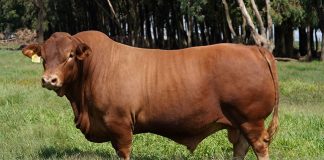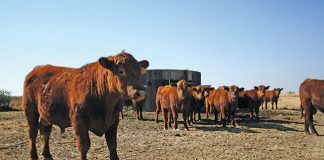Studies show that, in 2011, 66% of South Africa’s rangeland was in various stages of degradation, threatening sustainable vegetation, livestock and wildlife production, and ultimately farming profit. Veld condition and carrying capacity – usually expressed as the area in hectares needed to support either a mature or small stock unit – depends on plant cover, plant composition and production.
Methods to determine veld condition vary from sophisticated scientific techniques to a farmer’s hasty and subjective ‘back of a cigarette box’ estimation. A farmer should at least know if the grazing is improving, deteriorating or remaining reasonably stable. He can then keep the stocking rate in line with the carrying capacity of his farm.
A stocking rate exceeding the carrying capacity would obviously damage the veld, reducing animal performance and profitability. On the other hand, improving veld condition by sound management based on correct carrying capacity can increase it in the long term. Establishing the correct carrying capacity on a farm is not easy. Even though the agriculture department has recommendations for every district, carrying capacity can vary considerably from farm to farm and camp to camp.
For example, the norm for the red grass veld of the central Free State is 6ha/ MLU, but research shows it can vary in practice between 5ha/ MLU and 12ha/MLU depending on veld condition. So, while the department’s recommended carrying capacity is a practical guide, it cannot be blindly applied everywhere. Veld condition forms the best basis for determining carrying capacity.
Carrying capacity has always been a controversial subject due to the many factors that influence it. And, when any specific factor – from rainfall to management – changes, it alters the carrying capacity to a greater or lesser extent. Usually, rainfall is more important in arid areas than in areas of high rainfall. But in most of Southern Africa, the factors that dictate carrying capacity are, in order of importance: rainfall, available soil moisture, soil type, soil depth, evaporate-transpiration, veld condition, topography and livestock type.
A farmer should always consider current veld condition when deciding on the stocking rate. Learning basic veld evaluation techniques is valuable, while recognising the symptoms of deteriorating veld could help reverse the trend by changing aspects of the management system.
Grazing habits vary
Veld condition assessment is of little value if it is not linked to veld management which, in turn, is linked to balancing the needs of the livestock with the needs of the vegetation. The ideal is to apply a stocking rate based on a realistic carrying capacity that will allow the veld ecosystem to be used sustainably.
Knowledge of indicator plant species, for veld condition as well as the palatability and contribution of dominant species as livestock grazing, assists in assessing carrying capacity. It also helps to know that the diet preference of various species of livestock can vary through the year with changes in the palatability or availability of different plant species.
In a trial in the central Free State, the low creeping variation of creeping carrot seed grass (Tragus koelerioides) was utilised only by sheep. Red grass (Themeda triandra) was the most important species in this veld in the diet of both sheep and cattle. Finger grass (Digitaria eriantha) was selected by cattle as well as by sheep.
However, sheep preferred short finger grass (Digitaria argyrograpta), heartseed grass (Eragrostis superba) and palatable Karoo shrubs and herbs, irrespective of their percentage contribution to the veld’s total composition. Grazing pressure markedly changes the species composition of veld, especially in low-rainfall regions. Earlier research in the study area showed that red grass and Lehmann’s lovegrass (Eragrostis lehmanniana) decreased, whereas tassel three-awn grass (Aristida congesta) and creeping carrot seed grass increased with more intensive grazing during the summer. These changes persisted for nine years after withdrawing livestock.
The length of the grazing period will obviously have an influence on utilisation of species. As it extends, the high-preference species will decline and less palatable species will be grazed. Sheep tend to maximally graze preferred grasses before grazing relatively less palatable species.
Grazing pattern can vary from one veld type to the next. The ecological value of different species can also vary from place to place. For example, Lehmann’s lovegrass can range in status from climax in the Karoo areas of the southern Free State to sub-climax in the more arid west. In some areas, the greatest variation in the distribution of Lehmann’s lovegrass can be attributed to management, while in drier areas it could be attributed to rainfall.
The species is therefore less important in assessing veld condition.
What to focus on
Due to differences in seasonal rainfall, the relationship between veld condition and carrying capacity varies greatly from one growing season to another. A 15-year study in the central Free State showed that 65% of the variation in carrying capacity can be attributed to veld condition. The poorer the veld condition, the lower the carrying capacity.
This study also showed that forage production differs between species in semi-arid climates. Highly productive grasses produce 10 times more forage in any veld in good condition than in poor veld conditions with low producers such as awned, couch and carrot seed grasses.
The type of plant that grazing animals favour also changes with the growing season. They prefer relatively high-quality grasses, linked to the preference utilisation ratio of species. For example, sheep tend to graze less on red grass as it approaches dormancy, avoiding its tall growth and stalks.
Sheep seem to be less well adapted to pure climax grassland, and concentrate on shorter sub-climax and pioneer veld. This means that to efficiently utilise this semi-arid grassland type, both cattle and sheep must graze it. The fact that Merino sheep avoid long grasses and their stalks partly explains the difference between carrying capacity recommendations for
sheep and for cattle. According to the long-term red grass veld trial in the central Free State, the carrying capacity for cattle is 15% to 20% higher than that for sheep.
Browsers such as goats and certain antelope species further complicate the process of establishing carrying capacity. Veld condition is the condition of the vegetation in terms of forager production and resistance to degradation in the long term. An effective way to judge a camp is to look at the ratio between palatable perennial species and unpalatable or lower- producing annual species, while considering normal seasonal variation in rainfall and veld growth.
Evaluation
To maintain a sustainable stocking rate, a farmer should evaluate grazing conditions every two or three years. He should also be on the lookout for changes in the veld. If sub-climax or pioneer species are replacing indicator climax species, management may be at fault.
Adapted breeds that can be marketed off the veld after weaning should be chosen. These can usually obtain all their nutrition from the veld instead of licks. A farmer should avoid upsetting the grazing ecosystem by disturbing the balance between the needs of the grazing animal and the vegetation, as it can negatively affect sustainable income and increase soil degradation.
Email Dr Mias van der Westhuizen at [email protected].













